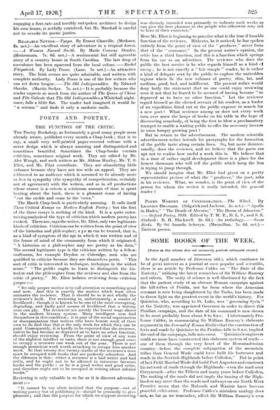SOME BOOKS OF THE WEEK.
[Notice Is this column does not necessarily preclude subsequent review.]
In the April number of Discovery (6d.), which continues to be of great interest as a journal at once popular and scientific, there is an article by Professor Calder on " The Date of the Nativity," utilizing the latest researches of Sir William Ramsay and others. The unity of science is well illustrated by the fact that the patient study of an obscure Roman campaign against the hill-tribes of Pisidia, not far from where the Armenian remnant is now being slaughtered by the Turks, has been made to throw light on the greatest event in the world's history. For Quirinius, who, according to St. Luke, was " governing Syria " at the Nativity, was appointed Governor in order to direct this Pisidian campaign, and the date of his command is now shown to be most probably from about 9 to 6 Lc. Unfortunately Pro- fessor Calder, in summarizing Sir William Ramsay's elaborate argument in the Journal of Roman Studies that the construction of forts and roads by Quirinius in the Pisidian hills in 6 B.C. implied the end of the campaign, falls into error. " Quirinius's engineers could no more have constructed this elaborate system of roads— one of them through the very heart of the Homanadensian country—before the complete subjugation of the mountain tribes than General Wade could have built his fortresses and roads in the Scottish Highlands before Culloden." But in point of fact Field-Marshal Wade did build Fort Augustus and construct his network of roads through the Highlands—even the road over Corryarrack—after the Fifteen and many years before Culloden. The making of the roads did not imply the taming of the High- landers any more than the roads and railways on our North-West Frontier mean that the Mahsuda and Waziris have become peaceful cultivators. Professor Calder's mistaken analogy does not, so far as we remember, affect Sir William Ramsay's own interpretation of the new inscriptions. The important thing is that St. Luke's accuracy, long questioned, is fully confirmed, and that the date of the Nativity was, in all probability, 8 a.0.



































 Previous page
Previous page